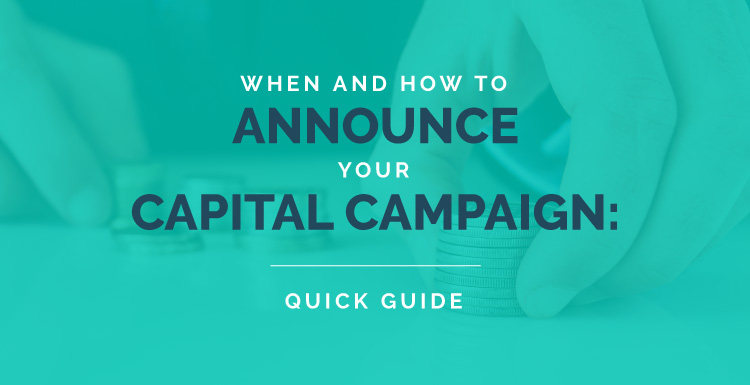
Let’s say you’re knee-deep in a major campaign. It’s been a long, busy year (or more) of fundraising work. You’ve defined your goals and objectives, gathered input, and laid out a plan for your capital campaign. You’ve raised the bulk of your campaign goal through one-on-one meetings with your organization’s top donors to explain your case for support and ask for gifts. You’re nearing the finish line and feeling excited about what success will mean for your constituents and community.
But you’re not done yet—so, what comes next?
To embark on the last stretch of your capital campaign, you’ll need to publicly announce it and kick off its public phase.
What’s the campaign kickoff?
The kickoff of a capital campaign announces the campaign, the amount of money already raised, and highlights the money still to be raised from the broader community. It marks the start of the public phase of the campaign that will push the campaign over its goal. It “kicks off” the beginning of the campaign’s public phase in which you’ll use larger-scale fundraising strategies, marketing materials, and events to get everyone excited to help you reach the goal.
Looking at the overall structure of a capital campaign, the kickoff comes after the quiet phase. This long period consists of prospect research, conversations with major donors, and solicitations of the campaign’s largest gifts. The quiet phase should end (and kickoff can occur) when you’ve secured 60-70% or more of your total fundraising goal.
Then, during kickoff and the public phase, you’ll raise the rest of your goal through smaller individual donations from your entire donor base and perhaps event sponsorships or other revenue streams, depending on your plans.
When should you announce your capital campaign?
There are four key indicators that mean you’re ready to announce your capital campaign to the community:
- You’ve already raised 60-70% of your goal from top donors.
- You have reviewed and adjusted (if necessary) the campaign goal you will announce publicly.
- You can project with some certainty where the money will come from to get you to the campaign goal.
- You have a plan for the final phase of the campaign.
Once these four indicators come into focus, you can confidently move ahead with planning your campaign kickoff. But why is it important to wait until these criteria line up before taking your campaign public?
Remember that capital campaigns are major investments and highly visible projects. Nonprofits only conduct them once a decade or so in order to fund significant initiatives that will increase their capacity and impact, like constructing a new building. Announcing a campaign, project, and timeline that you ultimately can’t stick to can cause stakeholders to lose confidence in your nonprofit’s abilities, harming your reputation and future fundraising potential.
Minimize this risk by 1) waiting to publicly kick off your campaign until you can satisfy the criteria above, and 2) using a flexible working goal that can be slightly adjusted until it’s clear how much money you will ultimately be able to raise during the public phase.
Why is announcing your campaign a necessary step?
Campaign kickoffs and public phases are important parts of the overall timeline for a few key reasons. Your campaign kickoff will:
- Announce the project being funded and the official fundraising goal of the campaign.
- Recognize the high-impact donors and campaign volunteers who’ve already contributed.
- Celebrate the progress you’ve made toward your campaign goal.
- Highlight the amount left to raise by a final deadline and the ways the community can help.
When a campaign kickoff accomplishes these objectives, it builds credibility, confidence, urgency, and excitement—feelings that are essential for convincing broader segments of your nonprofit’s community to support the campaign. Your campaign kickoff will generate a buzz around your organization’s plans and impact. And that buzz will help propel your campaign beyond the finish line.
What does a campaign kickoff entail?
The capital campaign kickoff and public phase look different for every organization because no two campaigns are alike. However, the core purposes of the kickoff (listed above) remain the same. And to accomplish these purposes, most kickoffs share a few characteristics. They usually involve:
- A special public event that invites the broader community to join
- Publicity and promotions to spread the word
- Recognition of the individuals who’ve helped and donated already
- An explanation that more needs to be done to reach a successful end
- A spirit of celebration and excitement
From there, the specifics of the kickoff can come in all shapes and sizes depending on the organization’s mission, brand, culture, campaign objectives, donor base, and more.
For example, we’ve seen a small private school host their casual kickoff in the cornfield where construction was soon to begin on their new facility. A small community gathering with seasonal treats, a bulldozer for photo ops, an inspiring speech from the school’s leaders, and local news coverage made for a successful and meaningful kickoff. Most importantly, the school’s leaders clearly explained what the new project would mean for students, what was still left to be raised, and when they expected to host a ribbon cutting.
Larger-scale kickoff events might also take the shape of a grand, elegant party. It all depends on what’s most appropriate for the culture of your organization, your unique campaign, and your community.
With all the hard work that goes into planning and launching a capital campaign, take the opportunity to celebrate once it’s clear that you’ll succeed. A campaign kickoff is an excellent way to rally the community, tell an exciting story about what you’re accomplishing, and recognize the supporters who’ve already helped. With planning and a clear understanding of the work that’s left, your kickoff will push you to (and perhaps far beyond) the finish line.
Step-by-Step Campaign Checklist & Guide
This intuitive guide breaks down each step of your campaign, and the timeline allows you to visualize your whole campaign, from start to finish. Download this free campaign checklist now!
Guest Authors: Amy Eisenstein, ACFRE, and Andrea Kihlstedt, Co-founders of the Capital Campaign Toolkit
Amy and Andrea co-founded the Capital Campaign Toolkit, a virtual support system for nonprofit leaders running successful campaigns. The Toolkit provides all the tools, templates, and guidance you need—without breaking the bank.

